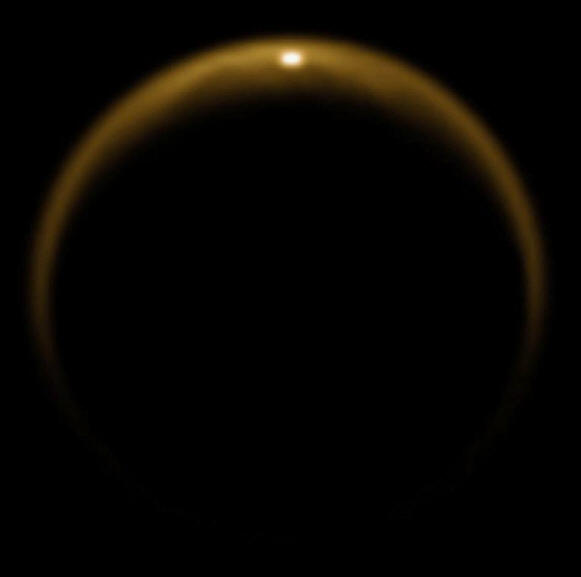Titan's Glass Lakes
Dec 28, 2009
Pools of liquid hydrocarbons are
said to exist on the surface of
Titan.On July 8, 2009, the
Cassini-Equinox spacecraft detected
a flash of reflected light from
Titan. Since the mission team had
been speculating about methane lakes
on Titan for some time before
launch, and since
early images from Cassini
seemed to show expanses of liquid on
its surface, the latest images are
said to "confirm" that speculation.
It was in January of 2005 that the
Huygens probe
successfully landed on the frigid moon. Mission specialists had
previously setup a sensor on the
bottom of the 319 kilogram capsule,
so that when it touched down an
indication of the landing zone's
composition could be established.
Prior to launch, the sensor was
plunged into a variety of
substances, including liquids and
ices, and those results were then
programmed into the software. One of
the substances was sand.Images
transmitted from the giant moon's
surface
revealed a rocky
landscape with the consistency of
damp sand. A field of
small pebbles extended to
the horizon. Spectrographic analysis
established that the "rocks" are
made of water ice. It is easy to
understand how ice can appear to be
like rock when it is at a
temperature of - 179 Celsius. What
Huygens did not detect was liquids
of any kind.
No methane droplets were falling
from the clouds. In fact, there was
no precipitation of any kind, and no
pools of methane were visible within
its field of view. Instead,
orbital images confirmed
a dry surface where dunes several
meters high march across the terrain
in parallel rows.
In the image at the top of the
page, the Cassini-Equinox orbiter
detected an infrared reflection from
an area known as Kraken Mare
("Monster Ocean") that covers more
than 400,000 square kilometers in
Titan's north polar region. Is
Kraken Mare really a lake larger
than Earth's Lake Superior?
Cassini has also returned images
of “riverbeds” that seem to flow
into several of the presumed methane
lakes, including Kraken Mare. As was
noted in a previous Picture of the
Day, the lakes on Titan are similar
to the “maria” of our own Moon.
Moreover, every brachiated channel
on Titan is dry; they all have dark,
flat floors, with no evidence of
flowing liquids. Coupled with the
observation that Titan's Kraken Mare
resembles
Mare Serenitatis more
than it does Lake Superior, the same
rilles are present on Titan as on
the Moon.
In
previous Picture of the
Day articles about the Moon,
"sinuous rilles" were identified as
the scars left by plasma discharges
of immense proportions. Practically
every body in the Solar System,
other than the gas giant planets,
exhibit such rille structures. The
ice moon Europa, the inferno-like
moon Io, the most remote planetary
moon Triton, Mercury, Venus, Mars,
Earth—without exception there are
steep-walled, meandering,
flat-floored canyon formations
everywhere our instruments look.
Electric Universe advocate Wal
Thornhill observed that the images
from Cassini are "...typical of arc
machining of the surface. I would
compare them directly to the
scalloped scarring on Jupiter’s moon
Io and the flat, melted floor
depressions that result. Such floors
would be expected to give a dark
radar return.”
The fact that the "lakes" are
also close by the vast dune fields
in the polar regions suggests an
electrical origin sometime in the
past. It is in the southern and
northern
latitudes of Titan that
they are found. Since electrical
activity has been shown to have
carved the surface of other rocky
bodies, why would it come as a
surprise to find that it has also
been at work on Titan? It is a
distinct probability that the
infrared light seen by Cassini was
reflected by the hard, glassified
crust left by an interplanetary
plasma discharge.
Stephen Smith







